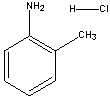
NTP Study Reports

NTP Study Reports
Home » Study Results & Research Projects » NTP Study Reports » All Long-Term Reports » Abstract for TR-153 - o-Toluidine Hydrochloride

| Chemical Formula: C7H9N·HCl | - | 3D Structure* | |
|---|---|---|---|
| *To view structure, download free Chemscape Chime Plug-in | |||
o-Toluidine and its hydrochloride salt are dye intermediates used in the manufacture of a large number of textile dyes which include some of the azo, triarylmethane, sulfur, and indigoid compounds. In addition, there are numerous substituted o-toluidines that are used as dye intermediates. o-Toluidine also functions as a photographic dye, as a reagent in a clinical assay for glucose and hemoglobin, and as an antioxidant in the manufacture of rubber.
A bioassay of o-toluidine hydrochloride for possible carcinogenicity was conducted by administering the test chemical in feed to F344 rats and B6C3F1 mice.
Groups of 50 rats of each sex and 50 mice of each sex were administered o-toluidine hydrochloride at one of several doses, either 3,000 or 6,000 ppm for rats and either 1,000 or 3,000 ppm for the mice, for 101 to 104 weeks. Matched controls consisted of 20 untreated rats of each sex and 20 untreated mice of each sex. All surviving rats and mice were killed at the end of administration of the test chemical.
Mean body weights of dosed male and female rats and mice were lower than those of corresponding matched controls and were dose related. Mortalities of the male and female rats were dose related and were relatively high at the end of the bioassay. Mortalities of the male and female mice were not, however, significantly affected by administration of the test chemical.
In rats, the administration of the test chemical induced several types of sarcomas of the spleen and other organs in both males and females, mesotheliomas of the abdominal cavity or scrotum in males, and transitional-cell carcinomas of the urinary bladder in females. Administration of the o-toluidine hydrochloride also resulted in increased incidences of fibromas of the subcutaneous tissue in the males and fibroadenomas or adenomas of the mammary gland in females.
In mice, hemangiosarcomas were induced at various sites in males, and hepatocellular carcinomas or adenomas were induced in females.
Under the conditions of this bioassay, o-toluidine hydrochloride was carcinogenic in both male and female F344 rats and B6C3F1 mice, producing a significant increased incidence of one or more types of neoplasms.
| Male Rats: | Positive | |
| Female Rats: | Positive | |
| Male Mice: | Positive | |
| Female Mice: | Positive |
Synonym: 2-aminotoluene hydrochloride
Report Date: 1979
Target Organs from 2-year Studies
You may link to the full technical report in pdf format ( Note: A print ready copy of the document is presented in Portable Document Format (pdf) which requires the Acrobat Reader plug-in -- download a free copy of the reader.)
Web page last updated on October 14, 2004
The National Institute of Environmental Health Sciences is one of the National Institutes of Health within the U.S. Department of Health and Human Services. The National Toxicology Program is headquartered on the NIEHS campus in Research Triangle Park, NC.